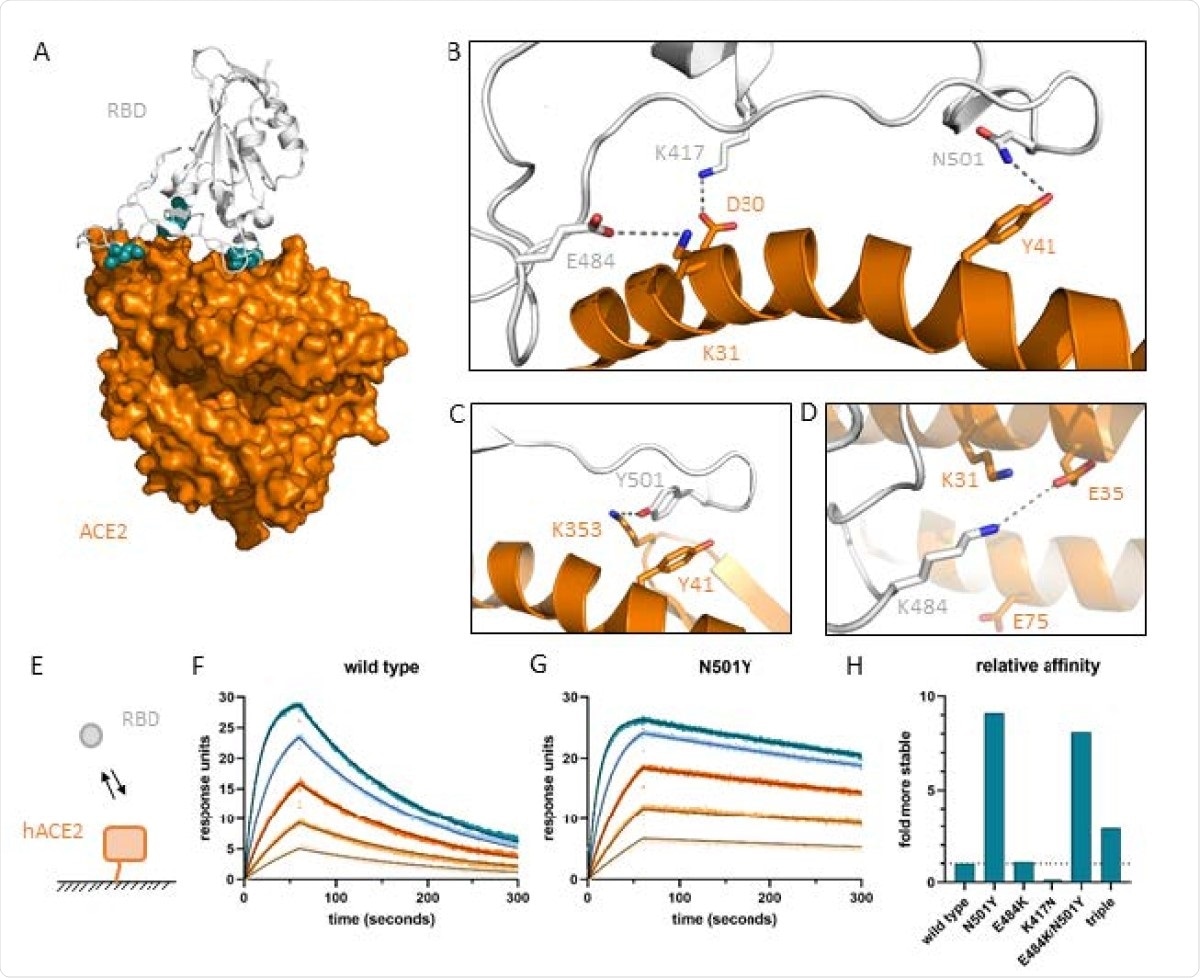Researchers at Erasmus University Medical Center in The Netherlands have explored how and why new variants of severe acute respiratory syndrome coronavirus 2 (SARS-CoV-2), the causative agent of coronavirus disease 2019 (COVID-19), have exhibited heightened infectivity.
-1.jpg)
They suggest that increased viral transmissibility in SARS-CoV-2 variants of concern is because of greater binding of the viral spike protein to the human angiotensin-converting enzyme 2 (hACE2) receptor of host cells.
The B.1.1.7 variant was initially detected in the United Kingdom and has grown to be the most prevalent strain after just a few months. It has a spike protein mutation called N501Y that is linked to higher infection rates and severe infection.
Another variant with similar features, B.1.351, arose in South Africa and has three genetic mutations on the spike protein receptor-binding domain — N501Y, E484K, and K417N — that can have exhibited greater resistance to immune responses than previous strains.
There are also concerns about an emerging double mutant E484K/N501Y.
Here we report experimental evidence for the changes in receptor binding affinities due to individual and different combinations of these RBD mutations,” wrote the researchers. “Taken together, our results show that receptor binding domains from rapidly spreading variants of SARS-CoV-2 bind with increased affinity to the hACE2 receptor and that this is predominantly caused by the N501Y mutation.”
The study “Experimental evidence for enhanced receptor binding by rapidly spreading SARS-CoV2 variants” is available as a preprint on the bioRxiv* server, while the article undergoes peer review.
Variant mutations cause molecular changes on receptor binding domain
The researchers report that mutations in the receptor-binding domain of B.1.1.7 and B.1.351 change how the virus interacts with the human ACE2 receptors.
Mutations in the variants affect molecular interactions in the receptor-binding domain. Asparagine 501 typically makes a single hydrogen bond across human ACE2 tyrosine 41. However, this was not observed with the new variants. Instead, tyrosine 501 creates a hydrogen bond with human ACE2 lysine 353.
The receptor-binding domain Y501 can pull hACE2 Y41 closer through favorable van der Waals interactions. The new variant mutation E484K avoids unfavorable energy bonds by forming an ion-pair with glutamate 35 in the human ACE2 alpha-helix structure. A mutation on the residue 484 can cause a small stabilization for binding with human ACE2 receptors.
N501Y enhances binding affinity for human ACE2 receptor
The team next looked at how the mutation N501Y influenced binding affinity with the human ACE2 receptor. They investigated the rate and affinity constants between different SARS-CoV-2 variants and the human ACE2 ectodomain using human cells.
Results showed the N501Y variant caused a 9.1-fold increase in binding affinity for human ACE2.
The change in affinity is predominantly caused by a reduction in the dissociation rate constant, indicating the N501Y spike protein remains bound to the receptor for a longer time period than wild type RBD, increasing the chance to undergo the proper conformational change and induce membrane fusion and cell entry,” explained the researchers.
However, the E484K mutation by itself had little change in binding affinity, showing a 1.1-fold.
The K417N in B.1.351 was found to be destabilizing as it destroyed a salt-bridge between human ACE2 by replacing lysine with a shorter asparagine. This translated to a slower binding and faster dissociation.
The combination of all three mutations, as present in strain B.1.351 (first identified in South Africa), results in a 3-fold less stable complex than for N501Y alone due to the effect of K417N, but still 3-fold more stable than with wild type RBD. As the K417T mutation in strain P.1 (first identified in Brazil) will likewise destroy the intramolecular salt bridge, we expect an intermediate affinity for this variant.”
For the emerging double mutant E484K/N501Y, the researchers found it shared a similar binding affinity to N501Y’s affinity towards human ACE2. The authors suggest this finding is most likely due to E484K having almost no effect on binding affinity.
Given the negligible effect of E484K on affinity, the authors suggest the P2 variant, which only carries E484K on the spike protein’s receptor binding domain, was most likely successful in spreading throughout Brazil because of its ability to evade the immune system rather than an increase in viral transmission.

Need for more genomic surveillance
The independent evolution of lineages containing mutations with different effects on receptor binding affinity, viral transmission and immune evasion underscores the importance of global viral genome surveillance and functional characterization,” concluded the researchers.
The total numbers of global cases are currently over 122 million. The United States leads the world with more than 28.2 million COVID-19 cases and over 500,000 deaths.
By understanding the genomic makeup of new variants, scientists can help modify vaccines that target and neutralize the new variants and adapt new vaccine strategies. Doing so can help with ongoing efforts towards herd immunity.
*Important Notice
bioRxiv publishes preliminary scientific reports that are not peer-reviewed and, therefore, should not be regarded as conclusive, guide clinical practice/health-related behavior, or treated as established information.
- Laffeber C, et al. Experimental evidence for enhanced receptor binding by rapidly spreading SARS-CoV2 variants. bioRxiv, 2021. doi: https://doi.org/10.1101/2021.02.22.432357, https://www.biorxiv.org/content/10.1101/2021.02.22.432357v1
Posted in: Device / Technology News | Medical Science News | Medical Research News | Healthcare News
Tags: ACE2, Amino Acid, Angiotensin, Angiotensin-Converting Enzyme 2, Asparagine, binding affinity, Cell, Coronavirus, Coronavirus Disease COVID-19, Enzyme, Evolution, Genetic, Genome, Genomic, Helix, Immune System, Ion, Lysine, Mutation, Pandemic, Protein, Receptor, Respiratory, SARS, SARS-CoV-2, Severe Acute Respiratory, Severe Acute Respiratory Syndrome, Spike Protein, Syndrome, Tyrosine, Vaccine, Virus

Written by
Jocelyn Solis-Moreira
Jocelyn Solis-Moreira graduated with a Bachelor's in Integrative Neuroscience, where she then pursued graduate research looking at the long-term effects of adolescent binge drinking on the brain's neurochemistry in adulthood.
Source: Read Full Article



